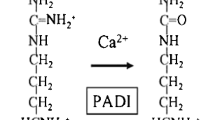Abstract
The HLA-DR4 gene complex plays a role in the pathogenesis of rheumatoid arthritis (RA). Auto-antibodies are a prominent serum feature of RA. In this study we explored the correlation of the HLA-DR4 gene complex with rheumatoid factor, anti-RA33/36 antibody, anti-keratin antibody (AKA) and anti-perinuclear factor (APF) in RA patients. Forty-five RA patients were involved in this study. The PCR-SSP method was used to examine the DR4 gene complex. Anti-RA33/36 antibody and RF were tested by Western blot and latex agglutination test respectively. AKA and APF were tested by the indirect immunofluorescence method. The DR4 gene complex is present in 60% of our patients. RF positivity was 68.9%. DR4(+) patients had a higher RF positive rate (66.7%) than DR4(−) patients (33.3%) (P<0.05). Anti-RA33/36 antibody was positive in 37.8% patients. It was present in 33.3% DR4(+) patients and in 38.9% DR4(−) patients. There was no significant difference. AKA (1∶80) was positive in 28.9% of our patients. It was present in 33.3% DR4(+) patients and in 22.2% DR4(−) patients. No significant difference could be found. APF could be detected in 53.3% of these patients. It was positive in 51.9% DR4(+) patients and 55.5% DR4(−) patients. There was no significant difference. In addition, no association could be found between RF, anti-RA33/36 antibody, AKA and APF. Therefore, although DR4 is an important indicator for severe RA and poor prognosis, it is only associated with RF. Moreover, no correlation could be found between these auto-antibodies.
Similar content being viewed by others
References
Weyand CM, Hicok KC, Conn DLet al., The influence of HLA-DRBI genes on disease severity in rheumatoid arthritis,Ann Intern Med 117, 801–806 (1992).
Deighton CM, Walker DJ, Griffiths IDet al., The contribution of HLA to rheumatoid arthritis,Clin Genet 36, 178–182 (1989).
Hasstedt SJ, Clegg DO, Ingles Let al., HLA-linked rheumatoid arthritis,Am J Hum Genet 55, 738–746 (1994).
Weyand CM, McCarthy IG, Goronzy JJ, Correlation between disease phenotype and genetic heterogeneity in rheumatoid arthritis,J Clin Invest 95, 2120–2126 (1995).
Ploski R, Mellbye OJ, Ronningen KSet al., Sero-negative and weakly sero-positive rheumatoid arthritis differ from clearly sero-positive rheumatoid arthritis in HLA class II associations,J Rheumatol 21, 1397–1402 (1994).
Hassfeld W, Steiner G, Hartmuth Ket al., Demonstration of a new antinuclear antibody (anti-RA33) that is highly specific for rheumatoid arthritis,Arthritis Rheum 32, 1515–1520 (1989).
Young BJ, Mallya RK, Leslie RD, Anti-keratin antibodies in rheumatoid arthritis,BMJ 2, 97–99 (1979).
Mei SE, Jiang M, Wang HZet al., Antiperinuclear factor in the diagnosis of rheumatoid arthritis,Chinese Med 75, 507 (1995).
Arnett FC, Edworthy SM, Bloch DAet al., The American Rheumatology Association 1987 revised criteria for the classification of rheumatoid arthritis,Arthritis Rheum 31, 315–324 (1988).
Pinals RS, Masi AT, Larsen RA, Preliminary criteria for clinical remission in rheumatoid arthritis,Arthritis Rheum 24, 1308–1315 (1981).
Laemmli UK, Cleavage of structural proteins during the assembly of the head of bacteriophage T4,Nature 227, 680–685 (1970).
Towbin H, Staehelin T, Gordon J, Electrophoretic transfer of proteins from polyacrylamide gels into nitrocellulose sheets: procedure and some application,Proc Natl Acad Sci USA 76, 4350–4354 (1979).
Simon M, Girbal E, Sebbag Met al., The cytokeratin filament aggregating protein filaggrin is the target of the so-called ‘anti-keratin antibodies’, autoantibodies specific for rheumatoid arthritis,J Clin Invest 92, 1387–1393 (1993).
Kurki P, Aho K, Palosuo Tet al., Immunopathology of rheumatoid arthritis. Antikeratin antibodies preceeds the clinical disease,Arthritis Rheum 35, 914 (1992).
Paimela L, Gripenberg M, Kurki Pet al., Antikeratin antibodies: diagnostic and prognostic marks for early rheumatoid arthritis,Ann Rheum Dis 51, 743–746 (1992).
Vincent C, Serre G, Lapeyre Fet al., High diagnostic value in rheumatoid arthritis of antibodies to the stratum of rat oesophagus epithelium, so-called ‘antikeratin antibodies’,Ann Rheum Dis 48, 712–722 (1989).
Hajiroussou NJ, Sebbag Met al., Significance of anti-keratin antibodies in rheumatoid arthritis,J Rheumatol 12, 57–63 (1985).
Kurki P, Aho K, Kaarala Ket al., Anti-keratin antibodies (AKA) defines a subset of seropositive erosive polyarthritis,Scand J Rheumatol 21 (suppl.), abstr. 137: 8 (1992).
Nienhuis RLE, Mandema E, Smids CA, A new serum factor in patients with rheumatoid arthritis: the anti-perinuclear factor,Ann Rheum Dis 23, 302–310 (1964).
Marmont AM, Damasio EE, Bertorello Cet al., Studies on the antiperinuclear factor,Ann Rheum Dis 10, 117–123 (1967).
Westgeest AA, Boerbooms AM, Jongmans Met al., Antiperinuclear factor: indicator of more severe disease in seronegative rheumatoid arthritis,J Rheumatol 14, 893–897 (1987).
Aho K, von Essen R, Kurki Pet al., Antikeratin antibodies and antiperinuclear factor as markers for subclinical rheumatoid disease process,J Rheumatol 20, 1278–1281 (1993).
Author information
Authors and Affiliations
About this article
Cite this article
Xinping, T., Jibo, W., Fulin, T. et al. Association of the HLA-DR4 gene complex with auto-antibodies in rheumatoid arthritis patients. Japanese Journal of Rheumatology 9, 219–227 (1999). https://doi.org/10.1007/BF03041279
Received:
Accepted:
Issue Date:
DOI: https://doi.org/10.1007/BF03041279



